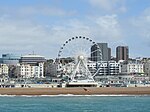Wellesbourne, Brighton
BrightonFormer riversRivers of East Sussex

The Wellesbourne (also spelt Wellsbourne, and occasionally Whalesbone) is a lost river which originally flowed into the English Channel in Brighton, part of the English seaside city of Brighton and Hove. It flowed southwards from Patcham, a village on the edge of the city, down the steep-sided valley along which the A23 London Road and the railway line to London now run. It was always an intermittent stream (a winterbourne) which flowed mostly in the winter and after periods of significant rainfall, and after a waterworks was built in 1889 it permanently stopped flowing.
Excerpt from the Wikipedia article Wellesbourne, Brighton (License: CC BY-SA 3.0, Authors, Images).Wellesbourne, Brighton
Brighton Queen's Park
Geographical coordinates (GPS) Address Nearby Places Show on map
Geographical coordinates (GPS)
| Latitude | Longitude |
|---|---|
| N 50.819722222222 ° | E -0.13666666666667 ° |
Address
BN2 1TW Brighton, Queen's Park
England, United Kingdom
Open on Google Maps











